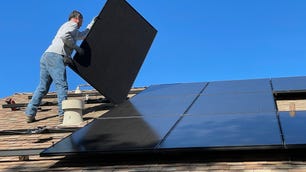Many homeowners thrive in the do-it-yourself approach to home renovations. It’s an easy way to save money and take better control over a project.
When it comes to something like installing a home battery system, your DIY skills might not be enough to get you by. Even if you feel like you can install it yourself, you might not get very far. Complex electrical work, permits and the battery’s terms and conditions documents could pose a roadblock.
Most of the time, “you want to find someone who’s certified to install that battery,” Cameron McDonald, vice president of merchandising, planning and inventory at Batteries Plus, told CNET.
Whether you’re eyeing a large Tesla Powerwall or a small Enphase IQ 5P (or any of the many other options), you most likely won’t be able to install it yourself. This is especially true if you want your home battery to be tied to the electrical grid. Here’s what you need to know about installing a home battery, and how to get it done safely and affordably.
Can you install a home battery system on your own?
“We get this question quite frequently,” said McDonald, who recognizes that many consumers are used to DIY installations for other types of appliances around the home.
Installing a home battery system isn’t like hooking up a washer or dryer, or even just plugging something into a wall outlet. These home battery systems are wired to your home’s main electrical panel, becoming a permanent part of your home’s electrical system. Most battery systems are grief-tied, which means the battery is connected to the power grid, drawing power from the grid when it needs to charge up. This is where the permits and inspections come in. A professional installer will be able to take care of all the paperwork and interconnection for you.
If you’re installing any kind of home battery that will be tied into your home’s electrical system, and therefore the larger power grid, you’re going to need a professional installer, McDonald said.
Most of the time, the purchase and installation of a home battery system go hand-in-hand, anyway. Most battery manufacturers have a network of professional installers that they outsource the actual installation of the battery to. Let’s say you’re interested in a Tesla Powerwall. If you contact Tesla, you won’t be getting a Powerwall from them. Tesla will take down your information and send it off to their network of certified installers. The nearest Tesla-certified installer to your location will take it from there.
Your journey doesn’t necessarily have to start by contacting the manufacturer. You could just reach out to local installers and see which types of batteries they install. Some homeowners even start with a solar panel installer that also installs home batteries. But again, professional installation is central to the process.
There are only a few battery manufacturers, like Bluetti and EcoFlow, that sell some home battery systems direct-to-consumer, without an installer or contractor involved. You would buy the battery right from the manufacturer’s website and it’s shipped right to your doorstep.
Even if you get a battery shipped directly to you, you’re still going to want a professional installer or electrician to hook it up to your home, McDonald said. Companies like EcoFlow have batteries that anyone can disconnect and move around, but you’ll want an electrician to hook up the panel or transfer switch that connects the battery to the home’s electrical panel.
Despite all of this, if you’re still really keen on a DIY installation (say, for a unique off-grid project) there are a few things you should know. First off, installing the battery system yourself could void your warranty. Most battery warranties state that any installation and maintenance work done to the battery must be done by a certified installer. Secondly, there’s the obvious safety risk involved in doing any kind of electrical work. Again, your local municipality or utility might actually require a permit for the installation.
DIY vs. professional home battery installation
Although the opportunities for a DIY battery installation are rare, they do exist. Here’s a look at the pros and cons of a professional installation versus a DIY installation.
Professional installation
This is the most common path for getting a home battery hooked up. You can get a professional installation lined up either directly from a manufacturer like Tesla or by contacting a local contractor who is certified to install different types of home batteries. Or on the flip side, if you’re purchasing a battery that ships direct-to-consumer, you could hire an electrician to set it up in your home.
Pros:
- You don’t need to worry about doing any electrical work yourself.
- You could get a discount if you bundle a battery installation with a solar installation.
- You won’t void the battery’s warranty,
- The installer will handle permits, inspections and paperwork.
Cons:
- Professional installations are more expensive than DIY.
- You might have to wait longer to find a contractor with availability to install your battery.
DIY installation
In the very rare cases where you have a home battery shipped directly to your door, and aren’t planning to establish a grid connection, a DIY installation might make sense. This wouldn’t be a typical “all-in-one” solution that many of the bigger manufacturers offer, but you could separately purchase the necessary system equipment and either hire an installer to help you hook it up or attempt to do it yourself. Just be aware of the safety risks involved.
Pros:
- Installing it yourself is cheaper than hiring a professional installer.
- You’ll have more control over the system’s design, setup and placement.
Cons:
- You expose yourself to the risks of working with electrical wires.
- You run the risk of voiding your warranty.
- You have very few battery options that allow a DIY installation.
How much does it cost to install a home battery?
There’s no one-size-fits-all answer to this question. Much like a solar installation, home batteries are a site-dependent purchase. Because every home’s energy needs are different, a price estimate for your home will likely be different than one for your neighbor’s home.
For a home battery, you can expect to pay anywhere between $1,000 – $1,500 per kilowatt-hour of energy storage capacity. That’s just for the battery. The actual installation of the battery system usually costs about $100 – $200 per kWh of energy storage, McDonald said. So, if you are installing a 15 kWh battery, expect to spend around $1,500 – $3,000 on installation costs. There are efficiencies of scale, so as battery size increases, the installation costs might start to level off. The best way to get an accurate home battery estimate for your home is to have a consultation with an installer.
Other factors affect installation costs, too:
- Geography: Depending on where you live, installer rates might be different. A state like California, for example, has some of the highest installation costs, McDonald said.
- Complexity: The more complicated your system’s design, the more expensive it’s going to be. The same goes for distance: If your battery is going to live really far away from your main electrical panel, it will cost more to run the wiring to connect the two.
- Contractor: Different installers will charge different rates. “Consumers, today more than ever, have more choices,” McDonald said. “Shop around and get different quotes.”






